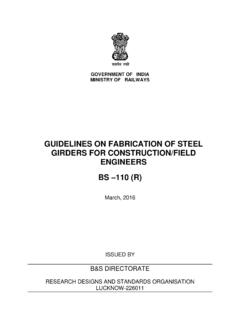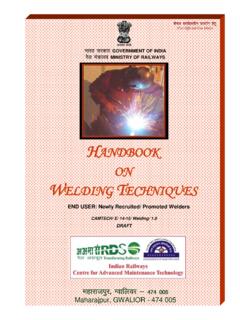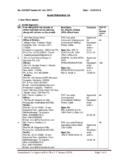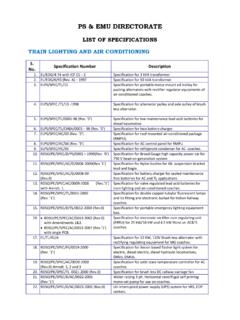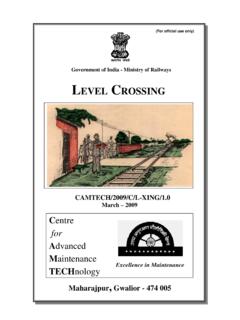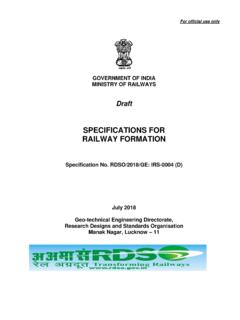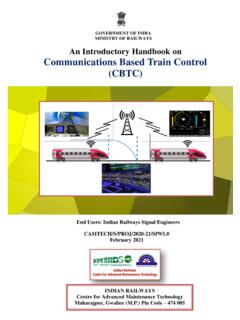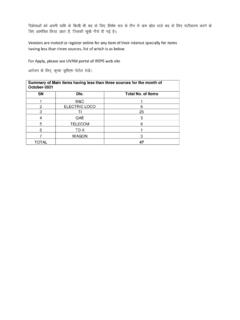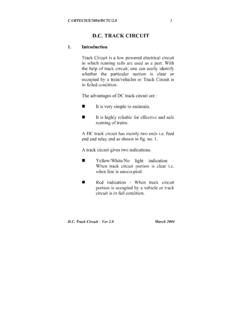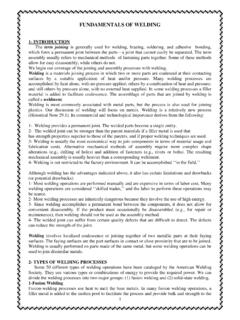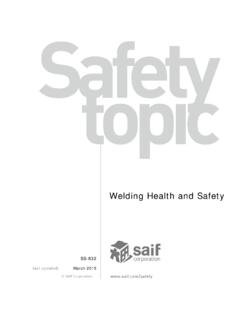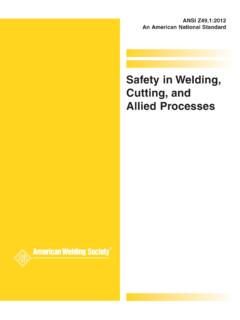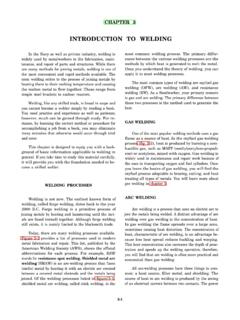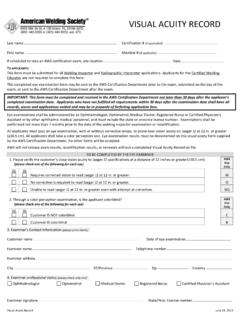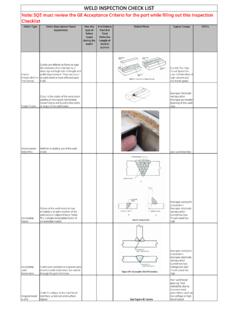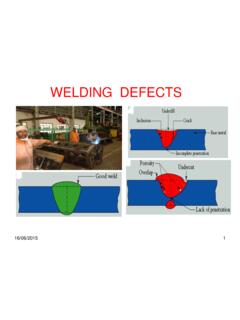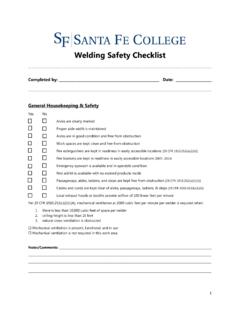Transcription of Draft Handbook on Selection of Welding ... - Indian Railways
1 Hkkjr ljdkj GOVERNMENT OF INDIA jsy ea=ky; MINISTRY OF Railways Maharajpur, GWALIOR - 474 005 dsoy dk;Zky;hu mi;ksx gsrq (For Official Use Only) SSEELLEECCTTIIOONN OOFF WWEELLDDIINNGG EELLEECCTTRROODDEESS END USER: WELDERS AND CONCERNED SSE/JES CAMTECH/ E/17-18/EP-3/ Welding Draft 2 CAMTECH/E/2017-18/EP-3/ Welding SSEELLEECCTTIIOONN OOFF WWEELLDDIINNGG EELLEECCTTRROODDEESS QUALITY POLICY To develop safe, modern and cost effective Railway Technology complying with Statutory and Regulatory requirements, through excellence in Research, Designs and Standards and Continual improvements in Quality Management System to cater to growing demand of passenger and freight traffic on the Railways . CONTENTS INTRODUCTION 01 FACTORS WHILE SELECTING ELECTRODE 01 Identify base metals 01 Weld Geometry (Joint Fit-up) 02 Welding Positions 04 Other Factors 06 CLASSIFICATION OF ELECTRODES 07 Mild steel electrodes 07 Welding Electrode Sizes 09 Indian Railways Specifications 09 SUMMARY OF MMAW ELECTRODES 10 CLASSIFICATION OF Welding ELECTRODES 12 (As per IRSM 28-2012)
2 GAS Welding RODS 32 USAGE AND STORAGE OF ELECTRODES 33 Usage and Storage of Electrodes 33 Storage of Electrodes 34 Drying Electrodes 35 REMEMBER 36 IS SPECIFICATIONS 37 REFERENCES 38 CAMTECH/E/2017-18/EP-3/ Welding 1 Handbook on Selection of Welding Electrodes Draft INTRODUCTION Welding is a skill that takes much practice to master, and selecting the correct electrode for the job can be equally challenging. Electrodes are available in a wide range of types, each of which provide different mechanical properties and operates with a specific type of Welding power source. The Selection of a correct type of Welding electrode for specific application is a very important consideration in metal arc Welding . Metal Welding electrodes are used for various applications on the Indian Railway such as in the construction and repairs of rolling stock, structures, bridges, permanent way etc.
3 FACTORS WHILE SELECTING ELECTRODE Factors we should consider when selecting an electrode include base metal type, joint fit-up and Welding positions. Identify base metals The first step in choosing an electrode is to determine our base metal composition. Our goal is to match (or closely match) the electrode composition to the base metal type, which will help to ensure a strong weld. If we are in doubt about the composition of base metal, ask our self following questions: 2 CAMTECH/E/2017-18/EP-3/ Welding Draft Handbook on Selection of Welding Electrodes Q. What does the metal look like? If we are working with a broken part or component, check for a coarse and grainy internal surface, which usually means the base material is a cast metal. Q. Is the metal magnetic? If the base metal is magnetic, chances are good that the base metal is carbon steel or alloy steel.
4 If the base metal is not magnetic, the material could be manganese steel, 300 series austenitic stainless steel or a non-ferrous alloy such as aluminium, brass, copper or titanium. Q. What kind of sparks does the metal give off when touched by a grinder? As a rule of thumb, more flare in the sparks indicates a higher carbon. Q. Does a chisel bite into the base metal or bounce off? A chisel will bite into a softer metal, such as mild steel or aluminium, and bounce off of harder metals, such as high carbon steel, chrome-moly or cast iron. Weld Geometry (Joint Fit-up) It is a joint configuration. It tells how two or more pieces of metal/component can be weld together. Five types of joints have been referred by the american Welding society : butt, corner, edge, lap, and tee. CAMTECH/E/2017-18/EP-3/ Welding 3 Handbook on Selection of Welding Electrodes Draft (i) Butt joint A joint between two members aligned approximately in the same plane (face to face) (ii) T- joint (fillet joint) A joint between two members located approximately at right angles to each other in the form of a T.
5 (iii) Corner joint A joint between two members located at right angles to each other at the edge of components. (iv) Lap Joint A joint between two overlapping members. (v) Edge joint A joint between the edges of two or more parallel or nearly parallel members. 4 CAMTECH/E/2017-18/EP-3/ Welding Draft Handbook on Selection of Welding Electrodes Application of Various Weld Joints Almost all types of weld configuration are being used in IR for fabrication of components. Under frame - fillet, butt, corner Coach steel superstructure - butt, fillet, corner Wagon - fillet, butt, corner Steel bridges - fillet, butt, corner, lap Welding Positions The american Welding society (AWS) has defined the four basic Welding positions. (i) Flat position In a flat position, a weld is performed along largely a horizontal axis and from above the joint.
6 It is the easiest type of weld to perform and to gain control over the weld pool and achieve the best weld quality. However the same position is some time called down hand Welding . CAMTECH/E/2017-18/EP-3/ Welding 5 Handbook on Selection of Welding Electrodes Draft (ii) Horizontal Position In the horizontal position, the weld axis is in the horizontal plane. Horizontal Welding is often used for fillet or groove welds. (iii) Vertical Position With a vertical position, the weld axis is largely in a vertical or upright position. It is typically more complicated to perform than flat and horizontal. When Welding is done on a vertical surface, the molten metal has a tendency to run downward and pile up. 6 CAMTECH/E/2017-18/EP-3/ Welding Draft Handbook on Selection of Welding Electrodes (iv) Overhead Position In this the most complicated of the four, the Welding is performed from the underside of the joint.
7 In this the metal deposited tends to drop or sag on the plate, causing the bead to have a high crown. Other Factors o Tensile strength of the required weld. o Base metal composition. o Electrode diameter o The rate of deposit the weld metal. o The type of current used. o Penetration required. o Metal thickness. o The experience of the welder. o The specifications and service Condition. CAMTECH/E/2017-18/EP-3/ Welding 7 Handbook on Selection of Welding Electrodes Draft CLASSIFICATION OF ELECTRODES Electrode: a coated metal wire having approximately the same composition as the base metal. Electrodes are mainly classified into 5 main groups: 1) Mild steel - majority of Welding 2) High carbon steel 3) Special alloy steel 4) Cast iron 5) Non ferrous - example Aluminum, Copper, & Brass Standards are set by AWS ( american Welding society ), ASTM ( american society for Testing Materials) & BIS ( Bureau of Indian standards).
8 Mild steel electrodes There are basically two kinds of mild steel electrodes: (i) Bare: Bare electrodes are still covered with little covering, this limits their use in the Welding field. (ii) Shielded (flux coated) Shielded electrodes have a heavy coating on the outside of them (called flux). 8 CAMTECH/E/2017-18/EP-3/ Welding Draft Handbook on Selection of Welding Electrodes Purpose of flux: It prevents corrosion from taking place. It acts as a cleaner and deoxidizes. It releases an inert gas to protect from oxygen, nitrogen, & hydrogen in the atmosphere. These elements will weaken the weld if they were to come in contact with the molten metal. It forms slag to protect the cooling metal & allows metal to cool at a slower rate protecting the metal properties. It provides easier starting arc, stabilizer, reduce splatter.
9 It permits better penetration & X-ray quality. As the electrode burns the flux produces a gaseous shield around the weld. This prevents harmful contaminants from hurting the weld. The main 3 harmful elements present in the atmosphere o Hydrogen o Oxygen o Nitrogen CAMTECH/E/2017-18/EP-3/ Welding 9 Handbook on Selection of Welding Electrodes Draft Welding Electrode Sizes The electrode size refers to the diameter of its core wire. Each electrode has a certain current range. The Welding current increases with the electrode size (diameter). Standard length of electrodes The electrodes are generally manufactured in the length of 250mm to 450mm. Indian Railways Specifications IRSM:28-2012 The Indian Railways has issued standard specification IRSM 28-2012 for manual metal arc Welding electrodes and gas Welding rods.
10 IRSM:46-2012 This specification has been framed for use of MIG (Metal Inert Gas) /MAG (Metal Active Gas) filler wire and classified into various classes as per the requirement of material to be welded. Electrode size Electrode size 10 CAMTECH/E/2017-18/EP-3/ Welding Draft Handbook on Selection of Welding Electrodes IRSM:39-2001 This specification has been framed for use of SAW (Submerged Arc Welding ) consumables and classified into various classes as per the requirement of material to be welded. SUMMARY OF MMAW ELECTRODES The summary of use of manual metal arc Welding electrodes as per parent material and use as per IRSM 28-2012 is given below: Parent Material Use Class of electrode Low tensile steel Static A1 -do- Moderate Dynamic A2 -do- Highly Dynamic/ low temperature A3, A4 Pipe Welding All application A5 Medium Tensile steel All standard application B1, B2 -do- Low temperature application below 200C B3, B4 High Tensile steel All application C1, C2 CAMTECH/E/2017-18/EP-3/ Welding 11 Handbook on Selection of Welding Electrodes Draft Parent Material Use Class of electrode Corten to IRS M-41 & IRS M-42 All application D Low & medium tensile steel Low heat input Welding E1 & E2 Cast irons For reclamation & repair F & G Ferrous components Hard facing of ferrous components H series Non ferrous metal & alloys (Cu & Al)
